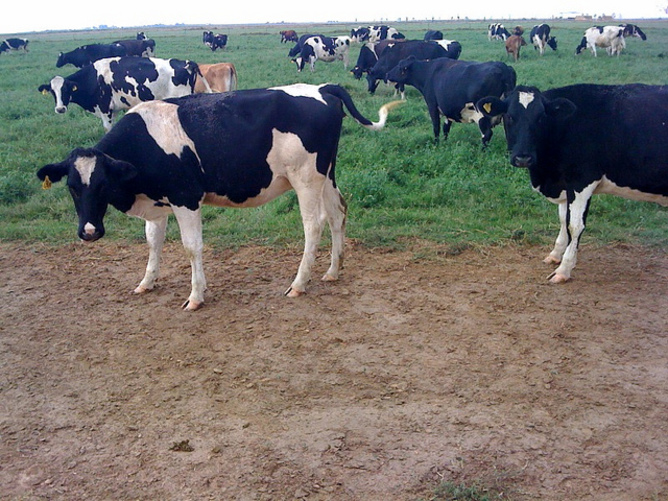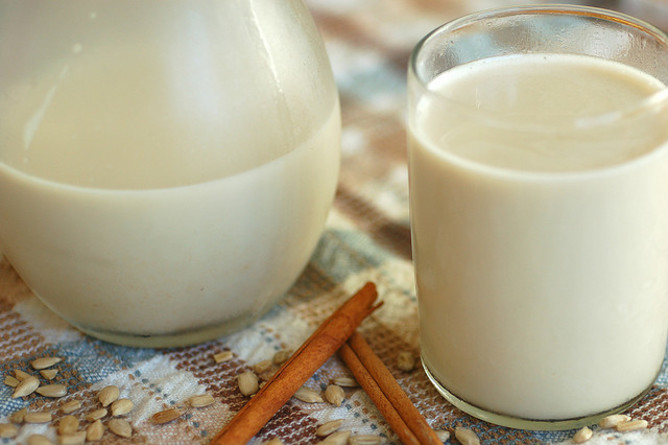There is no evidence that the health benefits of milk are compromised by pasteurisation. jacqueline/Flickr, CC BY-NC
Milk is a highly nutritious food, and an important source of amino acids and minerals such as phosphorus and calcium, which contributes to bone health.
Historically, milk was prone to contamination by bacteria from cows that could cause severe illness in humans. This remains the case with raw (unpasteurised) milk. The tragic death of a Victorian toddler this week is a stark reminder of these risks.
Pasteurisation involves heating the product to 72°C for 15 seconds. The method was originally employed to destroy bacteria in wine and beer that caused these products to spoil. It was quickly realised that this process could also be applied to milk to destroy harmful bacteria, and make milk safer for human consumption.
Pasteurisation was first introduced in Australia in the late 1950s and remains a legal requirement for milk produced for human consumption in Australia.
Nowadays, some of the important bacteria that pasteurisation targeted, such as those that cause tuberculosis, are no longer as problematic. So why do we continue to pasteurise milk?
The animals we use for milking can sometimes carry other pathogenic organisms that are capable of causing disease in humans. They can be found on hides or shed in the faeces.
Even healthy animals may be a source of organisms that are harmful to people. Such pathogens may be present in the farm environment, including soil, water, on pasture and in animal feeds. These pathogens can enter the milk during milking and if such milk is consumed, it can cause disease.
The most common pathogens found in association with dairy farms and milking animals include bacteria such as Escherichia coli (E. coli), Campylobacter and Salmonella, but other pathogens such as parasites like Cryptosporidium, a type of gastro, may also be present.

As soon as milk is secreted from the udder, it is at risk of contamination by many different bacteria.
cheeseslave/Flickr, CC BY
Campylobacter and Salmonella can cause severe diarrhoea and certain types of E. coli, particularly those known as Shiga toxin-producing E. coli (STEC), can cause very severe disease which impairs kidney function and may result in death.
Milk is highly nutritious to bacteria. Bacteria can quickly proliferate if their growth is not inhibited. Stopping the growth of bacteria in milk requires either heating to kill the bacteria, or chilling, which will not kill the bacteria but will slow down their growth.
E. coli, for instance, can go from ten cells to 100 million cells in just over six hours at 30°C. Only ten cells may be required to make someone ill. If such an organism is likely to be present, it’s important that any potential growth is stopped.
These harmful bacteria have caused outbreaks and disease associated with the consumption of raw milk in many countries. Data from the United States indicates that over a 13 year period to 2011, there were 2,384 illnesses, 284 hospitalisations and two deaths associated with the consumption of raw milk.
In Australia, raw milk contaminated by bacteria such as Campylobacter and Salmonella caused at least nine outbreaks of disease between 1997 and 2008, leading to 117 cases of illness.
So why do people choose to drink raw milk?
Advocates of raw milk often claim improved health benefit and nutritional value, or desiring a product which has not undergone further processing, retaining bacteria naturally present in milk.
But there is no evidence that the health benefits of milk are compromised by pasteurisation.
The defining difference between pasteurised and raw milk is the bacteria that are present. As soon as milk is secreted from the udder, it is at risk of contamination by many different bacteria as it makes its journey to our table. This includes harmful bacteria. These bacteria can lead to severe illness in humans, particularly children and the elderly.
For these reasons, raw milk continues to have a far higher risk of causing illness. Pasteurisation remains an important step in ensuring we can continue to enjoy safer, nutritious milk.
Further reading: Bath milk crisis must prompt better cosmetic safety regulation
This article was originally published on The Conversation.
Read the original article.



14th December 2014 at 5:49 pm
I agree Peter. Should we close all egg farms because of a case of Salmonella. Maybe we should ban eating fish because of a case of Ciguatera. Hysterics.
14th December 2014 at 11:27 am
CSIRO seems to provide biased propagando supporting the industrial food industry. Rather than providing real evidence on the real levels of risk (i.e. nuber of incidents, number of illnesses, number of fatalities) and compare them to many other common risks (food and others), all is just hot air and blown up and out of proportion in order to maintain industrial food systems control and not allowing informed citizens take their own response-ability for their choices. Regulations are OK, but banning something like raw milk is unacceptable and for a matter for fact is and has been widely available for purchase in many European countries for decades (or more), without such senseless hysteria coming from a zero risk attitude. For the specific farm where the raw milk came from in the recent, case they have extremely stringent practices, way beyond normal and they weekly test their milk and is always without problems.
I use raw milk, for making cheese (for which I pasereuse the milk myself), use in in tea (for which it is being automatically pasterised) and such, and for cooking. So rarely drink cold raw milk, but was growing up on it. The reason for using raw milk is its superior quality and taste, something you will not even find in the best organic or biodynamic milk, which has been centrally processed.
12th December 2014 at 10:14 pm
Courier Mail, 12/12/14. Page 5, Bottom left corner. “Check the Chook’s cooked” 30 struck down by food poisoning. 11350 foodborne illnesses confirmed this year. 500 people confirmed with Campylobacteriosis from eating underprepared Chicken & other Meat.
Makes Raw Milk look positively healthy, doesn’t it?
13th December 2014 at 5:25 pm
No it doesn’t!
The number of people who drink raw milk is miniscule compared to the number of people who eat meat. This more than explains the difference between about 11000 illnesses/year for meat compared to about 200/year for raw milk.
The raw milk illnesses are also completely preventable! Just pasteurise! At the very least, don’t give raw milk to young children or the very elderly.
12th December 2014 at 8:50 pm
So true, carton milk is tasteless.
12th December 2014 at 5:02 pm
I grew up drinking Raw Cows & Goats Milk until I was about 35 years old. It never did me or my children any harm. The white stuff they call Milk, isn’t. It doesn’t even taste like Milk.
12th December 2014 at 8:23 pm
Do you understand what circumstantial evidence is John Barr?
13th December 2014 at 1:57 pm
Are you saying that the child’s death was circumstantial? Please explain.
Personally I see the problem is one of reduced resistance to organisms caused by being overly protective & the harmful additives in our modern foods. Kids never play in dirt anymore because they might “get something,” yet they are fed all sorts of garbage masquerading as food. Everything has to be decontaminated & so clean & sterile that no one can build up a decent natural resistance to any diseases.
My guess is that this is how MAN will be the wiped of the face of the Earth in the not to distant future. No Global Warming, no Nuclear Holocaust it will be a self inflicted Pestilence.
13th December 2014 at 5:51 pm
Gretel is calling your evidence circumstantial (your evidence being that you or your children have not become sick). Your evidence doesn’t say anything about whether raw milk is dangerous or not, in the same way that you couldn’t say whether pool fences reduce drownings or not based on data from only one family.
I agree with you that reduced resistance is a problem. On the other hand, the leading causes of death in the not-so-distant past were diseases that people caught by food and water contamination and not being clean enough. It appears we need to strike a balance.
13th December 2014 at 11:57 pm
Seems to me that there a hell of a lot of people over 60 that all survived drinking Raw Milk off Dairies that did not have the W H & S in place those days. Not just my family & I. Even Raw milk gets Pasteurized just not Homogenised which destroys not only the Natural Fats but all other goodness in the Milk. The Natural Fats are digestible whereas the Homogenised fats are not fully digestible. The molecular structure has been changed.
Milking machines made the milking process much cleaner as compared to hand milking especially when the Cow shit or flicked it’s tail & stuff got in the milk. That’s why we strained it through muslin when we brought the bucket up. I guess if you grew up on a Dairy your immune system was a tad better than anyone else’s. My first Smallpox didn’t register so they gave (us) another, neither did that. I still don’t have the Smallpox scar that everyone else, of my age, got.
But you are right, kids brought up in the sterile home environment of the Cities these days are susceptible to everything. They’ve been filled up with all sorts of artificial crap & sterilized to the extent they would die just getting their hands dirty these days.
14th December 2014 at 6:32 pm
“Even Raw milk gets Pasteurized…”
No no no! Goodness no John! Not pasteurising is what makes it ‘raw’ milk!
I see your confusion: we’re talking about non-pasteurised milk here, the stuff that killed a child the other day and causes about 4 in 5 dairy-associated outbreaks despite the extremely low rate of consumption compared to pasteurised products.
You appear to be talking about non homogenised milk (you correctly describe homogenisation as changing the fats). Non homogenised milk (that has been pasteurised!!) is indeed safe, tasty, legal to sell for consumption, and probably available at your local market.
Please carefully re-read the explainer above!
12th December 2014 at 11:14 pm
Let’s say my family grew up smoking organic tobacco and eating cholesterol foods that can be much more prone to oxidised cholesterol and the damage it can do (seeming much worse that the evil omega 6 filled vegetable oils.
Not a good combination.